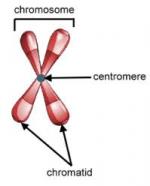|
This section contains 1,457 words (approx. 5 pages at 300 words per page) |

|
The bacterial or prokaryotic chromosome differs in many ways from that of the eukaryote. The term "eukaryote" comes from the Greek and means "true nucleus." Eukaryotic cells have a double membrane (the nuclear membrane) surrounding the nucleus, the organelle that contains several chromosomes. In contrast, the term "prokaryote" means "primitive nucleus," and, indeed, cells in prokaryotes have no nucleus. Instead, the prokaryotic chromosome is dispersed within the cell and is not enclosed by a separate membrane.
This dispersed chromosome is called the bacterial "nucleoid," which can be seen in electron micrographs of thin sections, as shown in Figure 2. Although bacteria (now called eubacteria) are highly diverse, the prototypical bacterial species is Escherichia coli, which has served as a model organism for genetic, biochemical, and biotechnological research for many decades.
The E. Coli Chromosome Is a Single Circle.
Because the single DNA molecule forming the chromosome is...
|
This section contains 1,457 words (approx. 5 pages at 300 words per page) |

|


